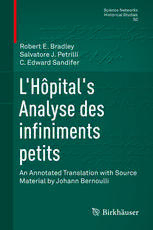Table Of ContentScience Networks
Historical Studies
50
Robert E. Bradley
Salvatore J. Petrilli
C. Edward Sandifer
L'Hôpital's
Analyse des
infiniments
petits
An Annotated Translation with Source
Material by Johann Bernoulli
ScienceNetworks.HistoricalStudies
FoundedbyErwinHiebertandHansWußing
Volume50
EditedbyEberhardKnobloch,HelgeKraghandVolkerRemmert
Editorial Board:
K.Andersen,Amsterdam S.Hildebrandt, Bonn
H.J.M.Bos,Amsterdam D.KormosBuchwald,Pasadena
U.Bottazzini, Roma Ch.Meinel,Regensburg
J.Z.Buchwald,Pasadena J.Peiffer,Paris
K.Chemla,Paris W.Purkert,Bonn
S.S.Demidov,Moskva D.Rowe,Mainz
M.Folkerts,München Ch.Sasaki,Tokyo
P.Galison,Cambridge, Mass. R.H.Stuewer,Minneapolis
J.Gray,Milton Keynes V.P.Vizgin,Moskva
R.Halleux,Liège
Moreinformationaboutthisseriesathttp://www.springer.com/series/4883
Robert E. Bradley (cid:129) Salvatore J. Petrilli
C. Edward Sandifer
L’Hôpital’s Analyse des
infiniments petits
An Annotated Translation with Source
Material by Johann Bernoulli
RobertE.Bradley SalvatoreJ.Petrilli
MathematicsandComputerScience MathematicsandComputerScience
AdelphiUniversity AdelphiUniversity
GardenCity,NY,USA GardenCity,NY,USA
C.EdwardSandifer
Newtown,CT,USA
ISSN1421-6329 ISSN2296-6080 (electronic)
ScienceNetworks.HistoricalStudies
ISBN978-3-319-17114-2 ISBN978-3-319-17115-9 (eBook)
DOI10.1007/978-3-319-17115-9
LibraryofCongressControlNumber:2015935196
MathematicsSubjectClassification(2010):01A45,01A75,26-03
SpringerChamHeidelbergNewYorkDordrechtLondon
©SpringerInternationalPublishingSwitzerland2015
Thisworkissubjecttocopyright.AllrightsarereservedbythePublisher,whetherthewholeorpartof
thematerialisconcerned,specificallytherightsoftranslation,reprinting,reuseofillustrations,recitation,
broadcasting,reproductiononmicrofilmsorinanyotherphysicalway,andtransmissionorinformation
storageandretrieval,electronicadaptation,computersoftware,orbysimilarordissimilarmethodology
nowknownorhereafterdeveloped.
Theuseofgeneraldescriptivenames,registerednames,trademarks,servicemarks,etc.inthispublication
doesnotimply,evenintheabsenceofaspecificstatement,thatsuchnamesareexemptfromtherelevant
protectivelawsandregulationsandthereforefreeforgeneraluse.
Thepublisher,theauthorsandtheeditorsaresafetoassumethattheadviceandinformationinthisbook
arebelievedtobetrueandaccurateatthedateofpublication.Neitherthepublishernortheauthorsor
theeditorsgiveawarranty,expressorimplied,withrespecttothematerialcontainedhereinorforany
errorsoromissionsthatmayhavebeenmade.
Coverillustration:FromWallerMsde-00215,AugustBeer:ÜberdieCorrectiondesCosinusgesetzes
beiderAnwendungdesNicol’schenPrismasinderPhotometrie,after1850.Withfriendlypermissionby
TheWallerManuscriptCollection(partoftheUppsalaUniversityLibraryCollections)
Printedonacid-freepaper
SpringerInternationalPublishingAGSwitzerlandispartofSpringerScience+BusinessMedia(www.
springer.com)
Translators’ Preface
Analyse des infiniment petits, pour l’intelligence des lignes courbes was the first
textbookofthedifferentialcalculus.ThetitletranslatesasAnalysisoftheinfinitely
small, for the understanding of curved lines. It was published anonymously in
Parisin1696,althoughmembersoftheFrenchmathematicalcommunitywerewell
aware that the author was Guillaume François Antoine de l’Hôpital,1 the Marquis
of Saint-Mesme (1661–1704). The textbook was successful, as evidenced by the
appearance of a posthumous second edition (L’Hôpital 1716), which identified
the author.2 Pierre Varignon (1646–1722), who was professor of mathematics at
Collège des Quatre-Nations in Paris and a friend of l’Hôpital, created a collection
ofclarificationsandadditionstotheAnalyse.Thesewerepublishedposthumously
(Varignon1725),afewyearsafterthe1716editionoftheAnalyse.Latereditionsof
the Analyse included similar commentary and continued to appear throughout the
18thcentury(L’Hôpital1768,1781).
Differential and integral calculus are generally considered to have their origins
intheworksofSirIsaacNewton(1642–1727)andWilhelmGottfriedvonLeibniz
(1646–1716)3 in the late 17th century, although the roots of the subject reach far
backintothatcenturyand,arguably,evenintoantiquity.Leibnizfirstdescribedhis
new calculus in a cryptic article more than a decade before the publication of the
Analyse (Leibniz 1684). For allpractical purposes, Leibniz’ early papers were not
1L’Hôpitalspelledhisname“Hospital”andthiswasthespellingusedintheposthumoussecond
edition of the text in 1715/1716. Fontenelle used the spelling “Hôpital,” which is the standard
modern spelling of the name, in his Eulogy (p. 295). There is no consensus among English-
languageauthorsoftheearly21stcenturyastowhichspellingoughttobeused.
2Technically, this was the third edition, despite the words “Seconde Edition” on the title page.
Therewasa“SecondeEdition”oneyearearlier(L’Hôpital1715),withmanytypographicalerrors,
ofwhichthe1716editionisacorrectedversion(Bernoulli1955,pp.499–500).
3Formoreontheprioritydisputeoverthediscoveryofthecalculus,whichisnotamatterofinterest
forthisvolume,seeHall(1980).
v
vi Translators’Preface
understood, until Jakob Bernoulli (1654–1705) and his younger brother Johann4
(1667–1748) began studying them in about 1687 and making discoveries of their
ownusinghistechniques.
Bernard de Fontenelle (1657–1757) became the secretary of the Académie des
Sciences in Paris in 1697 and wrote the eulogy of l’Hôpital for the academy’s
journal.Hesaidthatin1696,
...theGeometryoftheInfinitelysmallwasstillnothingbutakindofMystery,and,soto
speak,aCabalisticSciencesharedamongfiveorsixpeople.TheyoftengavetheirSolutions
intheJournalswithoutrevealingtheMethodthatproducedthem,andevenwhenonecould
discoverit,itwasonlyafewfeebleraysofthisSciencethathadescaped,andtheclouds
immediatelyclosedagain.5(Fontenelle1708,pp.133–134)
Later on, Jean Etienne Montucla (1725–1799) went one step further and listed
theonlypeoplethathebelievedunderstoodLeibniz’calculusbefore1696:Leibniz
himself, Jakob and Johann Bernoulli, Pierre Varignon and l’Hôpital (Montucla
1799, p. 397). L’Hôpital’s Analyse changed all of this and for much of the 18th
century,hisbookservedaspiringFrenchmathematiciansastheirfirstintroduction
tothenewcalculus.
For all that the Analyse was a popular and successful introduction to the
differentialcalculus,it’sremarkablethatthereisnoaccountoftheintegralcalculus
inthebook.InhisPreface,l’Hôpitalexplainedwhy
InallofthisthereisonlythefirstpartofMr.Leibniz’calculus,...Theotherpart,whichwe
callintegralCalculus,consistsingoingbackfromtheseinfinitelysmallquantitiestothe
magnitudesorthewholesofwhichtheyarethedifferences,thatistosayinfindingtheir
sums.Ihadalsointendedtopresentthis.However,Mr.Leibniz,havingwrittenmethathe
isworkingonaTreatisetitledDeScientiâinfiniti,Itookcarenottodeprivethepublicof
suchabeautifulWork...[p.liii].
Unfortunately,LeibniznevercompletedthisbookOntheScienceoftheInfinite.
The Analyse consists of ten chapters, which L’Hôpital called “sections.” We
consider it to have three parts. The first part, an introduction to the differential
calculus,consistsofthefirstfourchapters:
1. InwhichwegivetheRulesofthiscalculus.
2. Use of the differential calculus for finding the Tangents of all kinds of curved
lines.
3. Useofthedifferentialcalculusforfindingthegreatestandtheleastordinates,to
whicharereducedquestionsDemaximis&minimis.
4. Useofthedifferentialcalculusforfindinginflectionpointsandcusps.
Taken together, these chapters provide a thorough introduction to the differential
calculus in about 70 pages. The next five chapters are devoted to what can only
be described as an advanced text on differential geometry, motivated in part by
whatwerethencutting-edgeresearchproblemsinopticsandotherfields.Thefinal
4OftenreferredtoasJohann(I)BernoullitodistinguishhimfromhissonJohannandgrandson
Johann,whowerealsosuccessfulmathematicians.
5Thisquotationfromp.299ofthistext.
Translators’Preface vii
chapterismildlypolemical,demonstratingthesuperiorityofLeibniz’newcalculus,
when compared to the methods of René Descartes (1596–1660) and Johann van
WaverenHudde(1628–1704).
The RoleofJohannBernoulli
MostbiographicalinformationknownabouttheMarquisdel’Hôpitalcomesfrom
Fontenelle’s eulogy (Fontenelle 1708, pp. 116–146), a translation of which is
includedinChapter13ofthisvolume.However,Fontenelleknewlittleornothingat
thetimeofl’Hôpital’sdeathabouttheroleofJohannBernoulliinthecomposition
of the Analyse. L’Hôpital himself acknowledged a debt to Johann Bernoulli in his
preface:
IacknowledgehavingreceivedmuchfromtheilluminationsofMessrs.Bernoulli,particu-
larlythoseoftheyounger,presentlyProfessoratGroningen.Ihavemadeplainuseoftheir
discoveriesandthoseofMr.Leibniz.ThisiswhyIgrantthattheymayclaimasmuchof
thisastheymaywish,beingcontentwiththatwhichtheyarewillingtoleaveforme[p.liv].
Inlightofthis,itseemssomewhatstrangethatMontuclawouldwrite“Wemay
onlyfindfaultinthatMr.del’Hôpitaldidnotmakewellenoughknownthedebthe
owedtoMr.Bernoulli”(Montucla1799,p.397),buttherecordshowsthatJohann
Bernoulli’s influence on the structure and content of the Analyse was much more
significantthanthesewordsofrecognitionwouldsuggest.
Amongthefewdetailsknownaboutl’Hôpital’searlylife,Fontenellerecounted
thathesolvedoneof Pascal’sproblemsinvolvingthecycloidattheageof15.The
Marquis became a cavalry officer, but had only attained the rank of captain when
he resigned his commission due to poor eyesight. He devoted all of his energy to
mathematics from that point onward. Some time around 1690, he joined Nicolas
Malebranche’s(1638–1715)circle,whichwasengaged,amongotherthings,inthe
studyofhighermathematics.ItwasthereinNovember1691thathemetthe24-year-
oldJohannBernoulli,whowasvisitingParisandhadbeeninvitedbyMalebranche
to present his construction of the catenary at the salon. Although Fontenelle made
no mention of this meeting, it is documented by Spiess in his introduction to
the Bernoulli-l’Hôpital correspondence, which contains what may be considered
adefinitivebiographyoftheMarquisdel’Hôpital(Bernoulli1955,pp.123–130).
There is no contemporary account of this meeting. Bernoulli wrote of the
encounter in his autobiography, which he composed in 1741, but Spiess considers
an earlier account that he gave in a letter to Pierre Rémond de Montmort (1678–
1719) to be more reliable; see Bernoulli (1955, p. 135–137). In May 21, 1718,
Bernoulli told Montmort that upon meeting the Marquis, he soon found him to
beagoodenoughmathematician withregardtoordinarymathematics,butthathe
knew nothing of the differential calculus, other than its name, and had not even
heardoftheintegralcalculus.L’HôpitalhadapparentlymasteredFermat’smethod
of finding maxima and minima and told Bernoulli that he had used it to invent a
rule for determining the radius of curvature for arbitrary curves. The method was
viii Translators’Preface
unwieldy and actually could only be used at local extrema of algebraic curves.
Bernoullishowedhimtheformulafortheradiusofcurvaturethathehaddeveloped
withhisbrotherJakob,whichemployedsecond-orderdifferentials.Apparently,this
so impressed the Marquis that he visited Bernoulli the very next day and engaged
himashistutorinthedifferentialandintegralcalculus.
TheMarquisdeL’Hôpital(1661–1704)–portraitinwalnutbySusanPetry,2014,25(cid:2)19(cid:2)3
cm.;photographbytheartist
Translators’Preface ix
BernoullitutoredtheMarquisinhisParisapartmentfourtimesaweekfromlate
1691 through the end of July 1692. We are fortunate that l’Hôpital insisted that
Bernoulli commit his lessons to paper. Bernoulli typically composed each lesson,
whichhewroteinLatin,thenightbeforehegavethemtotheMarquis.Fortunately,
his friend and later colleague at the University of Basel, Johann Heinrich von
JohannBernoulli(1667–1748)–portraitincherrybySusanPetry,2014,26(cid:2)19(cid:2)4cm.;
photographbytheartist

